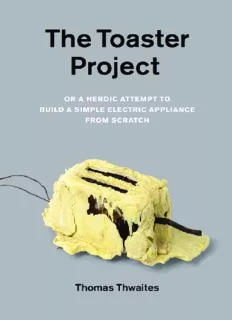
The toaster project: Or a heroic attempt to build a simple electric appliance from scratch PDF
Preview The toaster project: Or a heroic attempt to build a simple electric appliance from scratch
The Toaster Project Or a herOic attempt tO build a simple electric appliance frOm scratch Thomas Thwaites PrinceTon ArchiTecTurAl Press · new York left to his own devices he couldn’t build a toaster. he could just about make a sandwich and that was it. —Douglas Adams, Mostly Harmless (1992) 006 DeDicATion / coPYrighT For Merle, Bette,Vito & Felix Published by Princeton Architectural Press 37 East 7th Street, New York, NY 10003 For a free catalog of books call 1-800-722-6657 Visit our website at www.papress.com © 2011 Thomas Thwaites All rights reserved Printed and bound in China 14 13 12 11 4 3 2 1 First edition No part of this book may be used or reproduced in any manner without written permission from the publisher, except in the context of reviews. Every reasonable attempt has been made to identify owners of copyright. Errors or omissions will be corrected in subsequent editions. Editor: Sara Bader Designer: Paul Wagner Special thanks to: Bree Anne Apperley, Nicola Bednarek Brower, Janet Behning, Fannie Bushin, Megan Carey, Becca Casbon, Carina Cha, Tom Cho, Penny (Yuen Pik) Chu, Russell Fernandez, Jan Haux, Linda Lee, John Myers, Katharine Myers, Margaret Rogalski, Dan Simon, Andrew Stepanian, Jennifer Thompson, Joseph Weston, and Deb Wood of Princeton Architectural Press —Kevin C. Lippert, publisher Library of Congress Cataloging-in-Publication Data Thwaites, Thomas, 1980– The toaster project, or A heroic attempt to build a simple electric appliance from scratch / Thomas Thwaites. — 1st ed. p. cm. Includes bibliographical references. ISBN 978-1-56898-997-6 (alk. paper) 1. Thwaites, Thomas, 1980—Themes, motives. 2. Manufactures— Miscellanea. I. Title. II. Title: Heroic attempt to build a simple electric appliance from scratch. NK1447.6.T49A35 2011 683'.83—dc22 2011006094 conTenTs 007 Foreword 009 Preface 013 1 Deconstruction 016 2 steel 044 3 Mica 088 4 Plastic 100 5 copper 134 6 nickel 156 7 construction 166 Acknowledgments 187 Bibliography 190 Image Credits 191 The ToAsTer ProjecT 009 Foreword by David crowley Where do the products that fill our lives come from? “China” is, of course, the standard answer to this question. The “dragon economy’s” mammoth factories are high in our consciousness, drawing the attention of environmentalists worried about the effects of breakneck industrialisation and Western politicians troubled about competition. But “China” is an inadequate answer. Where do our things really come from? What lies behind the smooth buttons on your mobile phone or the elegant running shoes on your feet? What is involved in extracting and processing the materials that give themselves up from the earth so reluctantly? Where does the copper in your “Made in China” kettle come from? Were the electronic components and integrated circuits in your TV remote control assembled by machine or by hand? And what exactly has been integrated in that circuit anyway?
Description: